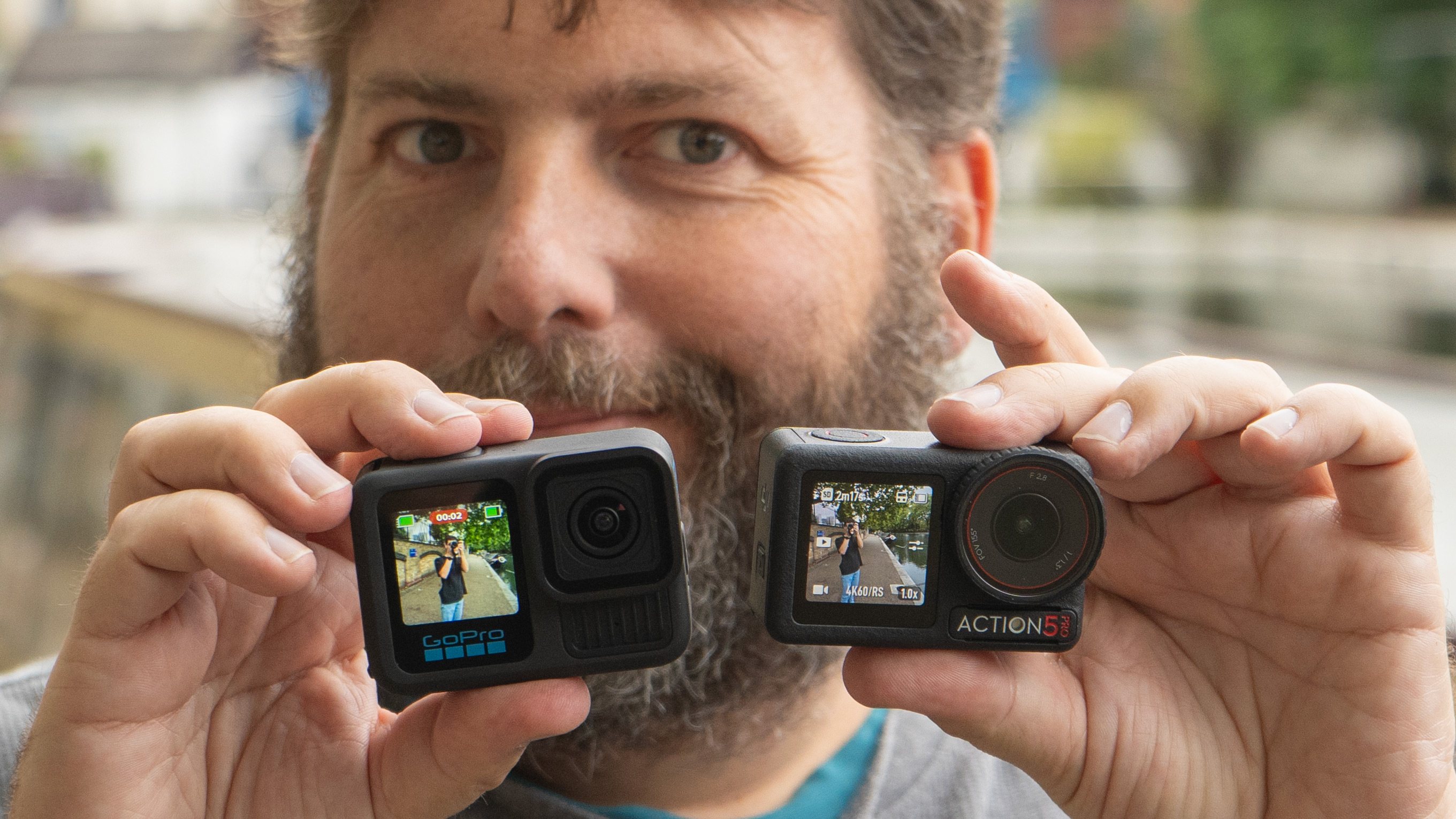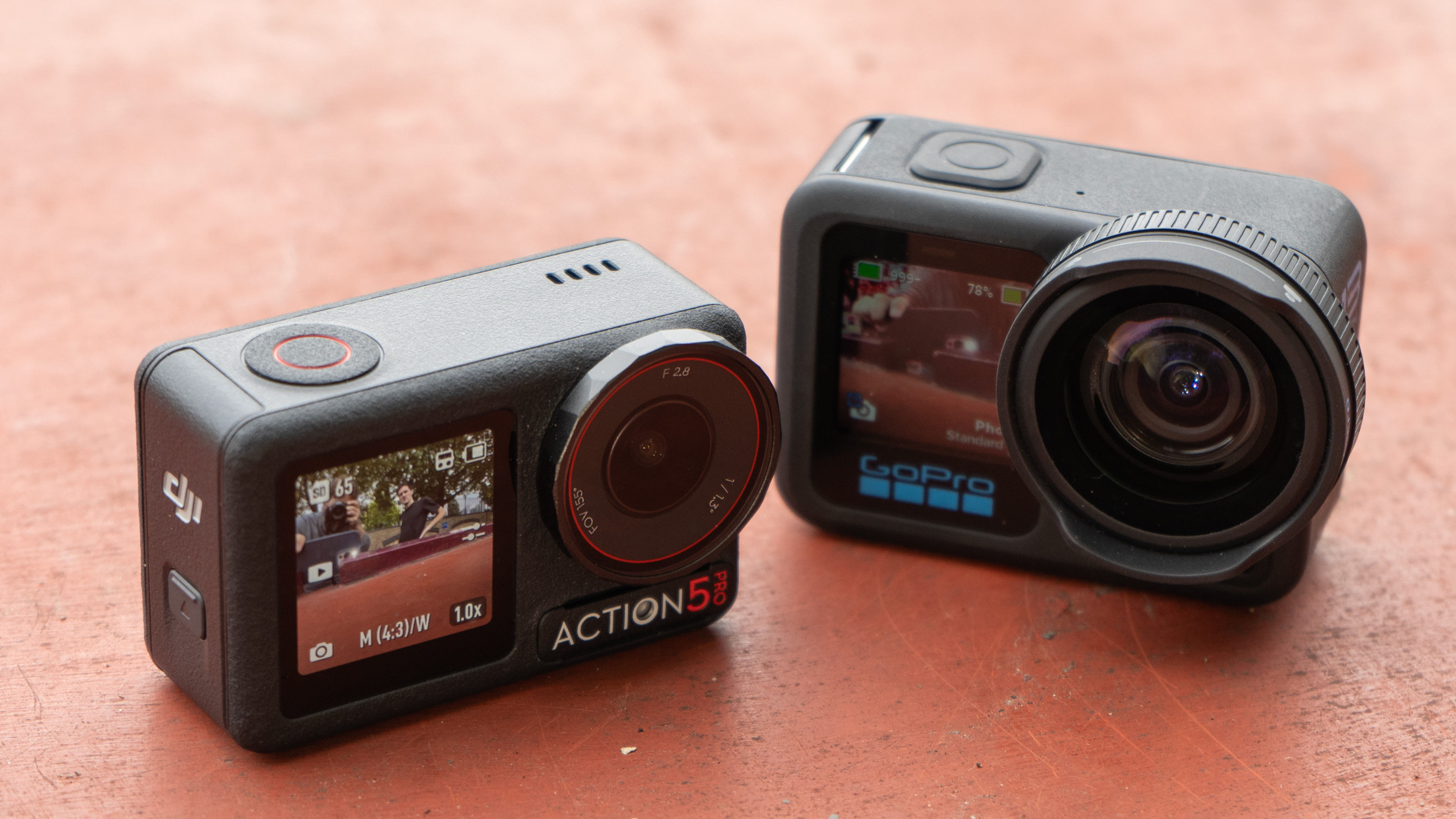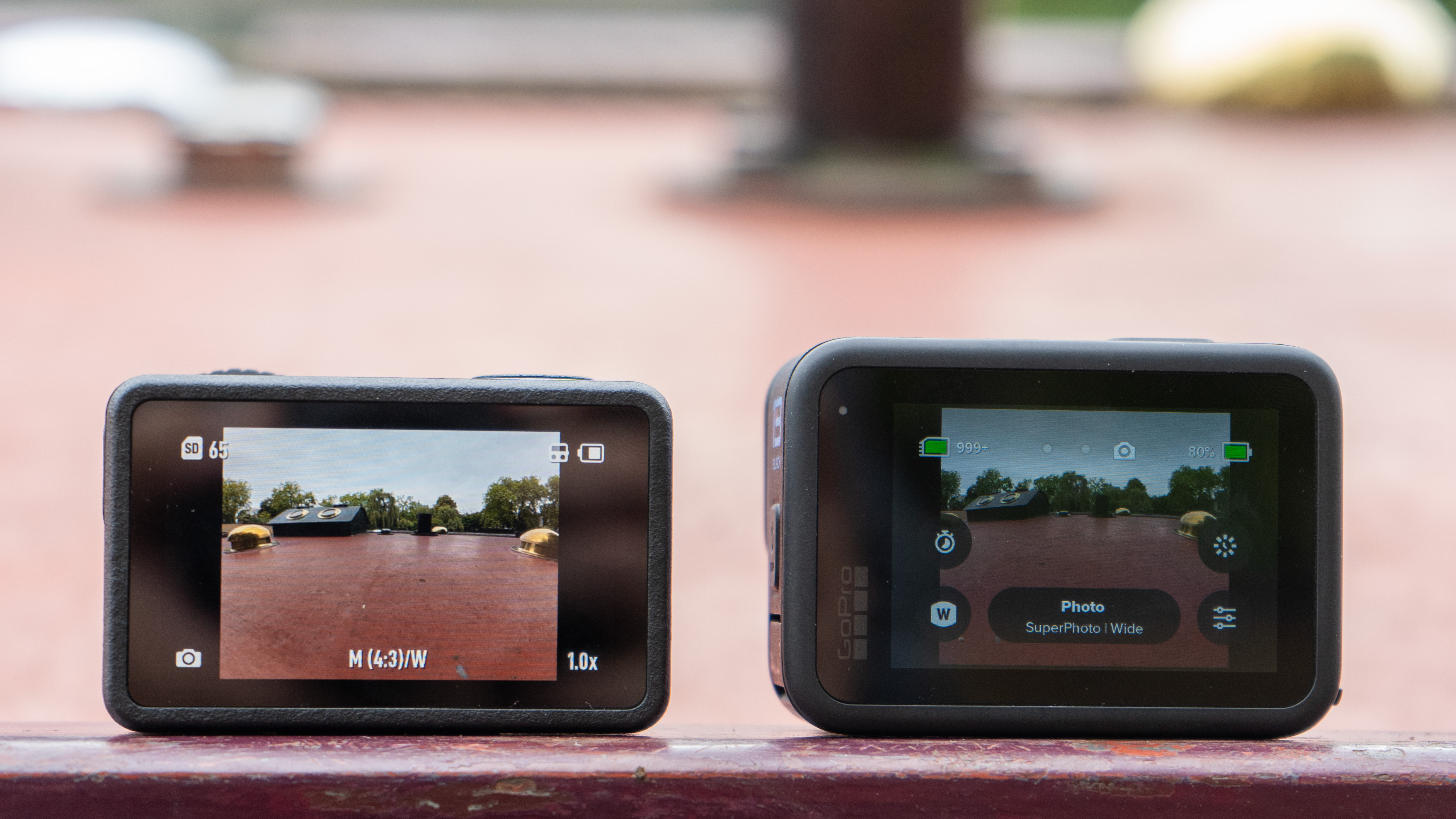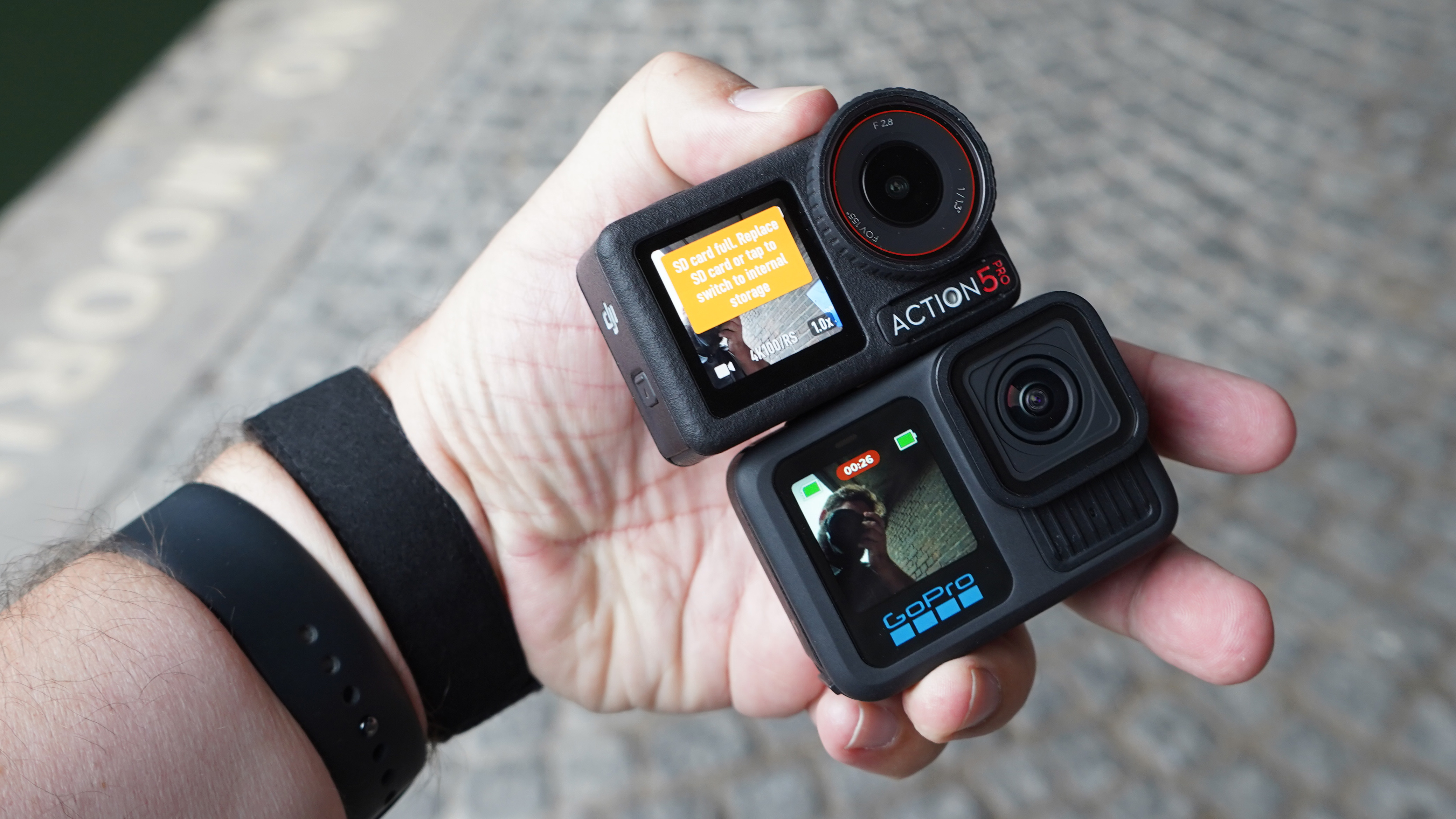DJI Osmo Action 5 Pro v GoPro Hero 13 Black – the head vs heart of action cameras!
The new DJI Osmo Action 5 Pro versus the GoPro Hero 13 Black – which is the ultimate action camera?

In what is now something of a pattern, just a couple of weeks after the new GoPro Hero 13 Black, DJI hit back with the new Osmo Action 5 Pro. GoPro is probably still the most famous brand – it literally created the action camera concept – but last year the DJI Action 4 comfortably won the best action camera crown in not just my view, but that of many in the industry.
That was before DJI even thought of adding 'Pro' to the end of the name! How did DJI earn top spot? Partly because GoPro actually took features away from the previous year's model (GoPro DJI now seem to release a new model once a year) and partly because DJI really stepped things up in terms of image performance by boosting the image sensor size.
This generation both made significant changes – but both still have the same size image sensor. What, now, separates the cameras if you're asking which to get?
Round 1: New Features
GoPro Hero 13 Black
- Easily swappable lens with sensor
- GPS is back
- Magnetic mount (finally!)
- Bigger battery (2.5h)
DJI Action 5 Pro
- Pressure height/depth sensor
- Subject tracking AI
- SuperNight mode
- Bigger battery (4h)
The GoPro Hero 13 is all about the lenses. The big new feature that GoPro has brought to the table this time is a system for not only fitting lens filters and adapters. There is a wide angle and an anamorphic one (now, as I update this article months later, I can say that the GoPro Anamorphic Lens Mod is finally released). What is cool about the system is that the Hero 13 but detects them automatically so you don't need to resort to menus. This means you can have the creativity of a pro, but it keeps everything simple and fun to use when you've got, well, action on the mind!
The other feature that's arrived on the Hero 13 that wasn't on the 12 is GPS, which means you can create overlays to your videos depicting speedometers as the camera can record its movement. This was in a lot of previous GoPros, but the company decided to take it out.
GoPro has also, finally, looked at the good work DJI and Inata360 have done with their magnetic mounts and added on of their own. These don't replace the flap-out grips, so no worries there, but brilliantly magnets can guide a new mount into clips. It doesn't feel as firm as DJI's but it uses the magnets more cunningly, as it is reversible.
DJI, by contrast, has introduced a new image sensor (albeit the same size), giving the camera 13.5 stops of dynamic range. There is another new sensor – a pressure sensor – for collecting altitude & depth metadata!
The best camera deals, reviews, product advice, and unmissable photography news, direct to your inbox!
The new DJI also has a much bigger battery capacity (up to 4 hours recording), and an AI-driven tracking feature which can be used so you can set the camera down and it can keep a vertical subject in frame as they move around. Other handy features include 'Highlight' (marking key moments for editing as they happen), built-in on-camera storage of 47GB and pre-record.
Round 2: Quality & Performance
GoPro Hero 13 Black
- Exciting options for cinamatography
- 8:7 sensor still interesting for social
DJI Action 5 Pro
- 13.5 stops of dynamic range
- Far better in low light
- 4nm processsor
Having played around with both for a little, the fit and finish on the DJI is probably a very narrow win. I like that GoPro has dropped the blue flecking from the previous design (that looked like it would age badly), but the DJI device is pure simplicity and the quality of the bigger, brighter, crisper screens is easily apparent (the fact the DJI opts for a brighter default setting suggests more confidence in the battery too).
That said, the lens swap system on the GoPro is a lot easier to grasp and operate than the process of replacing the lens cover on the DJI since the new jaunty rim (under the rubber shield in the photo) is actually harder to grip! (In fairness you won't actually need to do this a lot or at all.)
Video resolution is mathematically better from GoPro – it offers 5.3K video – but, in reality, the 4K output from DJI's 2.4 micron pixels offers a much better dynamic range, which means the camera can cope in conditions beyond daylight; even better this time thanks to the new SuperNight mode. If you do timelapses in low light, shoot videos from your bike while cycling at night, or take videos caving, GoPro has, frankly, been eclipsed.
In terms of menu usability, GoPro has a system which works and has stuck with it, boosting battery life over the older models with a new (non-compatible) battery. DJI has opted for a new processor which you can feel in snappy menu performance and further improves battery life to over 3 hours (up to 4, DJI say, in perfect conditions!)
Final Round: Verdict
GoPro Hero 13 Black
- Exciting options for cinamatography
- GoPro seem to understand the 'heart' of customers
- Return of GPS for in-body speed measuring.
- Battery life is better than other GoPros, but...
DJI Action 5 Pro
- Simply put this is a better camera, especially in low light.
- Subject tracking is a great tool for vertical social creators.
- Excellent crisp touchscreens on both sides.
- ...the best battery life by over an hour!
Ultimately, as I said, this is very much about the head v the heart. To my mind, DJI has stayed ahead of the game when it comes to the camera tech, but GoPro has given us a new reason to crave an action camera we might not have thought of.
The Osmo Action 5 Pro is measurably better than the Action 4 it supersedes, and that was better than the GoPro 12. Measureably the keyword there because it does it in all the same increments, and looks very similar, even if it has 'Pro' written on it.
The GoPro Hero 13 doesn't bother to improve the imaging system. On the face of it, that hands DJI a massive win here, but instead, I think it splits things. GoPro instead opens up a battle on a new front DJI doesn't appear to have thought of.
For most people, the idea of an anamorphic adapter or an even wider lens probably isn't that useful if we're honest. You do sacrifice some convenience, and it even introduces an extra issue. You'll need to make sure dust doesn't get in there. DJI-owners won't need to worry about that. It also seems to add cost, even before subscriptions are mentioned (and GoPro do love to sell subscriptions).
But there's no getting away from it, as a photo fan, my heart is trained to feel that swappable lenses are better. I've done it on my drones (like the DJI Inspire 3) and I can sort of do it on my phone (though all the lenses have a camera each). Personally, I'd lean to the Action 5 for the kind of shots I take (because bad lighting is just part of my world), but if I had more cinematic ambitions I can absolutely see the lure of the GoPro this time – and that isn't something I could say last generation!
(This article was first published 18 Oct 2024 and subsequently updated)
If you still can't separate them, check our full GoPro Hero 13 Black review and the DJI Action 5 Pro review with sample videos.
It's also worth noting that, since the initial release, GoPro has created a bundle called the Hero 13 Black Ultra Wide that includes the wide-angle lens which can save a bit of cash if you're looking to pick that up on day one.

With over 20 years of expertise as a tech journalist, Adam brings a wealth of knowledge across a vast number of product categories, including timelapse cameras, home security cameras, NVR cameras, photography books, webcams, 3D printers and 3D scanners, borescopes, radar detectors… and, above all, drones.
Adam is our resident expert on all aspects of camera drones and drone photography, from buying guides on the best choices for aerial photographers of all ability levels to the latest rules and regulations on piloting drones.
He is the author of a number of books including The Complete Guide to Drones, The Smart Smart Home Handbook, 101 Tips for DSLR Video and The Drone Pilot's Handbook.



